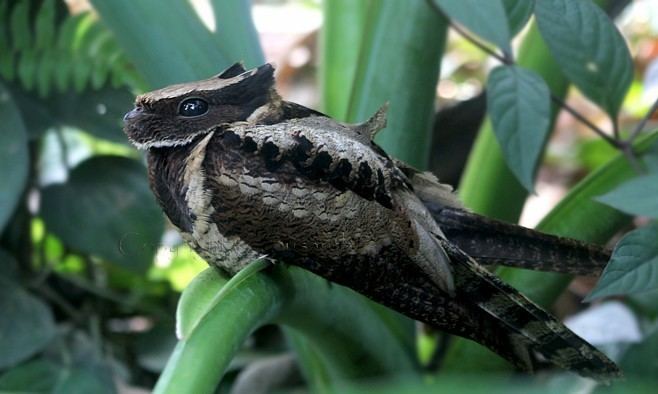Rank Species | Scientific name Lyncornis macrotis Higher classification Lyncornis | |
 | ||
Similar Eurostopodus, Malaysian eared nightjar, Philippine nightjar, Satanic nightjar, Jerdon's nightjar | ||
Great eared nightjar lyncornis macrotis
The great eared nightjar (Lyncornis macrotis) is a species of nightjar in the family Caprimulgidae. It is the largest species in the family in terms of length, which can range from 31 to 41 cm (12 to 16 in). Males weigh an average of 131 g (4.6 oz) and females weigh an average of 151 g (5.3 oz) so it the second heaviest species in the family after the nacunda nighthawk.
Contents
- Great eared nightjar lyncornis macrotis
- Facts
- Distribution and habitat
- Behaviour
- Breeding
- Taxonomy
- References

Facts
- Owing to a legend according to an ancient folk tale that narrates the story of a Great Eared Nightjar sucking milk from goats, they are sometimes also called goatsuckers.
- Their family name actually comes from the Latin word Caprimulgus, which literally means goatsucker.
- Antarctica is the only continent that does not have any species of the Nightjar. A few island groups such as Madagascar and the Seychelles do not have any Nightjar population as well.
- A Great Eared Nightjar has a peculiar habit of resting and roosting on roads. This is also one of the leading causes of their deaths which have led to a sharp decrease in their population in many parts of the world.
- The bird's body is cryptically coloured to look like leaves and bark to help them camouflage with their surroundings to evade predators. This is why some species of this bird, including the Great Eared Nightjar, prefer perching along a branch rather than sitting across it, as it helps them stay undiscovered during the day. Sometimes the Great Eared Nightjar can also camouflage as a viper snake, owing to their large ‘ears’.
- Although the Great Eared Nightjar species are typically non-migratory and are resident birds, other varieties of the species that live in the far north of the world, such as the European Nightjar or the Common Nighthawk, migrate towards the South through the beginning of winter.
- As these birds usually nest on the ground, it has been observed that other species, including the Great Eared Nightjar, move their eggs and young ones from the nesting site, during danger or an attack, simply by carrying them in between their beaks, much like cats and dogs.
- Although the Great Eared Nightjar is placed under a separate family of Nightjars named Eurostopodidae, this family has not yet been extensively adopted worldwide.
- The IUCN, also called the International Union for Conservation of Nature, has categorized and evaluated the Great Eared Nightjar species and has listed them as "Least Concern". This means that their species is not endangered.
- The Great Eared Nightjars are capable of daily torpor, which is a mechanism or a strategy that lets them decrease their body temperature at will as a means of cutting back energy during periods of low environmental temperature or low food accessibility and availability.
- The Thattekad Bird Sanctuary in Kerala, which boasts over 270 species of birds, is the only bird sanctuary in India with over 5 species of the Nightjar, including the Great Eared Nightjar.
- In the ancient times, night-flying birds or nocturnal birds- such as the Great Eared Nightjar - were associated with witch craft and black magic.
- Due to their feet being weak and their legs very short , these birds usually hop about clumsily on the ground, much like a sparrow.
- Great Eared Nightjar have a reflective membrane behind their retina (tapetum) that helps them in enhancing their vision during the night by increasing the light-gathering and reflecting ability of its eyes.
- These birds do not voice or call out when they hear the calls made by predatory nocturnal animals, such as owls. This is a survival instinct that has been seen in all species of the Nightjar.
Distribution and habitat

It is found in Southeast Asia with populations in the Western Ghats and Sri Lanka. Indonesia, India, Laos, Malaysia, Myanmar, the Philippines, Thailand, and Vietnam. Its natural habitat is subtropical or tropical moist lowland forests.
Behaviour

Like other nightjars they are active at dusk and at night. They have a distinctive call which includes a sharp tsiik followed by a pause and a two-syllable ba-haaww.
Breeding

The nest of the species is a simple scrape on the ground, and typically the clutch contains only one egg. The chicks are well camouflaged among leaf litter, aiding in their protection from predators.
Taxonomy
Several populations are given subspecies status and include:
